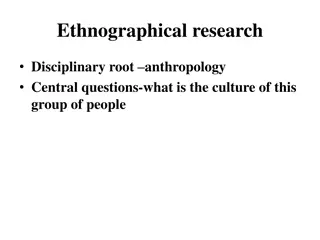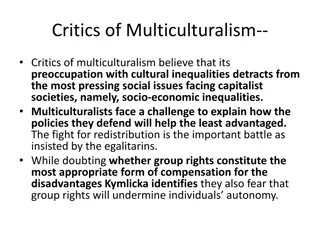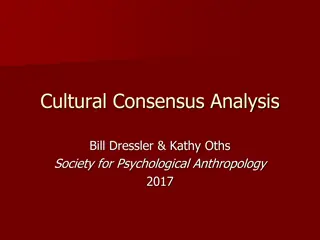Understanding Ethnography: Art and Science of Cultural Description
Ethnography is the method of describing a group or culture through up-close experience and participation. This social science research technique focuses on contextual, unobtrusive, and collaborative characteristics that involve interpretative analyses and organic interactions. Data collection is unstructured, emphasizing observation in natural settings to interpret human actions and meanings.
Download Presentation

Please find below an Image/Link to download the presentation.
The content on the website is provided AS IS for your information and personal use only. It may not be sold, licensed, or shared on other websites without obtaining consent from the author. Download presentation by click this link. If you encounter any issues during the download, it is possible that the publisher has removed the file from their server.
E N D
Presentation Transcript
"Ethnography is the art and science of describing a group or culture. The description may be of a small tribal group in an exotic land or a classroom in middle-class suburbia." --David M. Fetterman, 1998. Ethnography came from the Greek ethnos = folk/people and graphein = writing. It identifies its roots in sociology and anthropology.
Ethnography is a social science research method. It relies heavily on up-close, personal experience and possible participation, not just observation, by researchers trained in the art of ethnography. It involves a commitment to get close to the subject being observed in its natural setting, to be factual and descriptive in reporting what is observed, and to find out the points of view of participants in the domain observed.
CHARACTERISTIC OF ETHNOGRAPHIC RESEARCH CONTEXTUAL The research is carried out in the context in which the subjects normally live and work UNOBTRUSIVE The research avoids manipulating the phenomena under investigation. LONGITUDINAL The research is relatively long.
CHARACTERISTICS OF ETHNOGRAPHIC RESEARCH COLLABORATIVE The research involves the participation of stakeholders other than the researcher. INTERPRETATIVE The researcher carries out interpretative analyses of the data. ORGANIC There is interaction between questions/ hypotheses and data collection/ interpretation.
(a) People's behavior is studied in everyday contexts, rather than under experimental conditions created by the researcher. (b) Data are gathered from a range of sources, but observation and/ or relatively informal conversations are usually the main ones. (c) The approach to data collection is "unstructured in the sense that it does not involve following through a detailed plan set up at the beginning; nor are the categories used for interpreting what people say and do pre-given or fixed. This does not mean that the research is unsystematic; simply that initially the data are collected in as raw a form, and on as wide a front, as feasible.
(d) The focus is usually a single setting or group, of relatively small scale. In life history research the focus may even be a single individual. (e) The analysis of the data involves interpretation of the meanings and functions of human actions and mainly takes the form of verbal descriptions and explanations, with quantification and statistical analysis playing a subordinate role at most.
NATURALISM This is the view that the aim of social research is to capture the character of naturally occurring human behavior, and that this can only be achieved by first-hand contact with it, not by inferences from what people do in artificial settings like experiments or from what they say in interviews about what they do elsewhere.
UNDERSTANDING From this point of view, if we are to be able to explain human actions effectively we must gain an understanding of the cultural perspectives on which they are based. That this is necessary is obvious when we are studying a society that is alien to us, since we shall find much of what we see and hear puzzling.
DISCOVERY Another feature of ethnographic thinking is a conception of the research process as inductive or discovery-based; rather than as being limited to the testing of explicit hypotheses.
The design of an ethnographic research is deceptively simple. It appears to require only one act naturally. Then again, looking beyond, conducting an ethnographic research is a process of discovery. It is something that cannot be programmed. It is not a matter of following methodological rules but a practical activity requiring the exercise of one s judgment.
Typical ethnographic research employs three kinds of data collection: interviews, observation, and documents. This in turn produces three kinds of data: quotations, descriptions, and excerpts of documents, resulting in one product: narrative description. watching what happens listening to what is said asking questions through informal and formal interviews collecting documents and artifacts
The data collected include, in addition to the rich descriptive accounts, photographs, maps, figures, tables, texts, audio and video records, and transcriptions. The most common types of method used in data collection are interviews [both formal and informal], documents [also both formal and informal/ official], and through observation.
In conducting an ethnographic research, there are also certain ethical concerns that are being raised every now and then. Over-all, they can be summarized as: informed consent privacy harm exploitation























